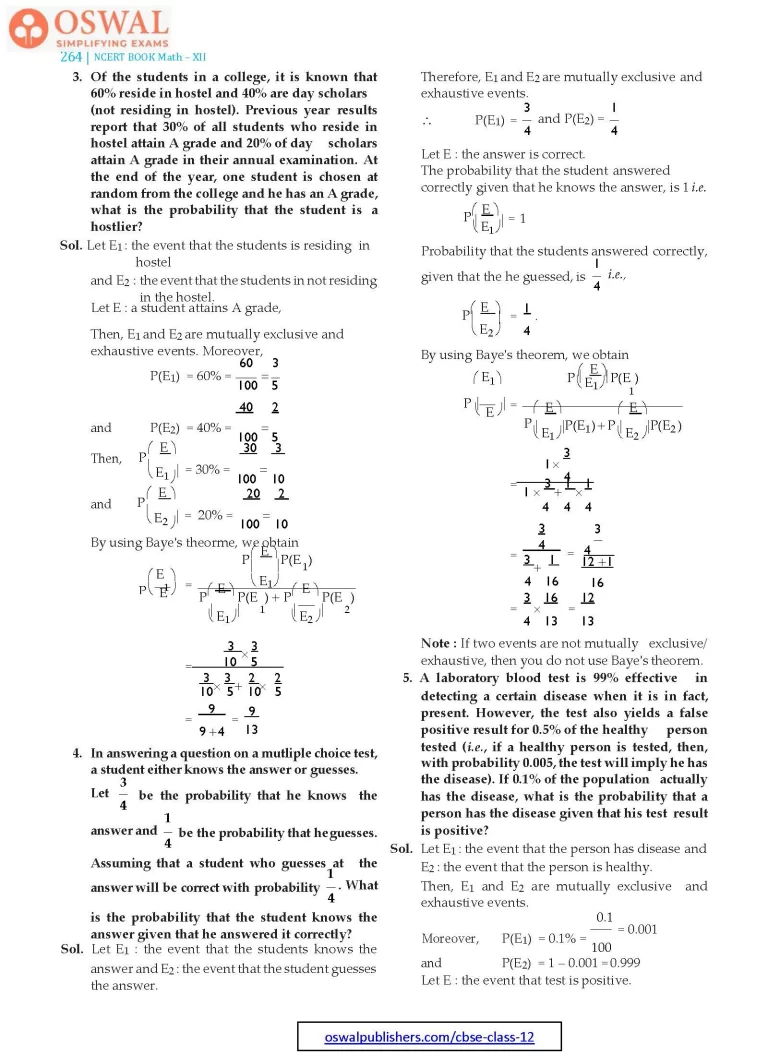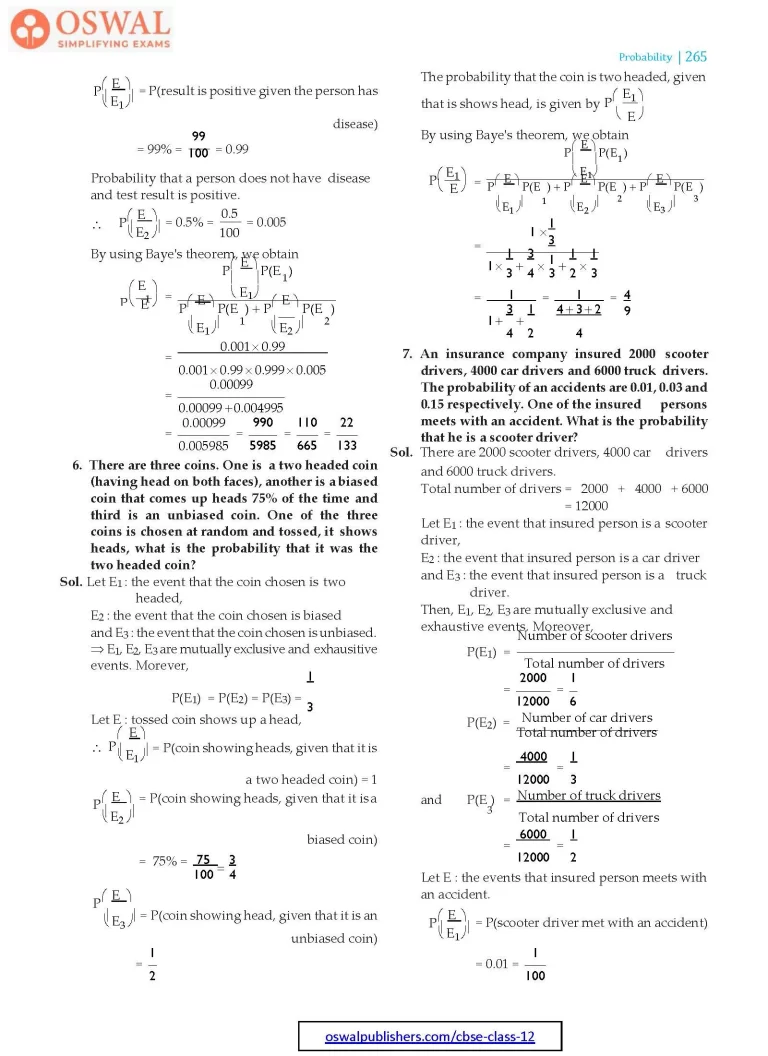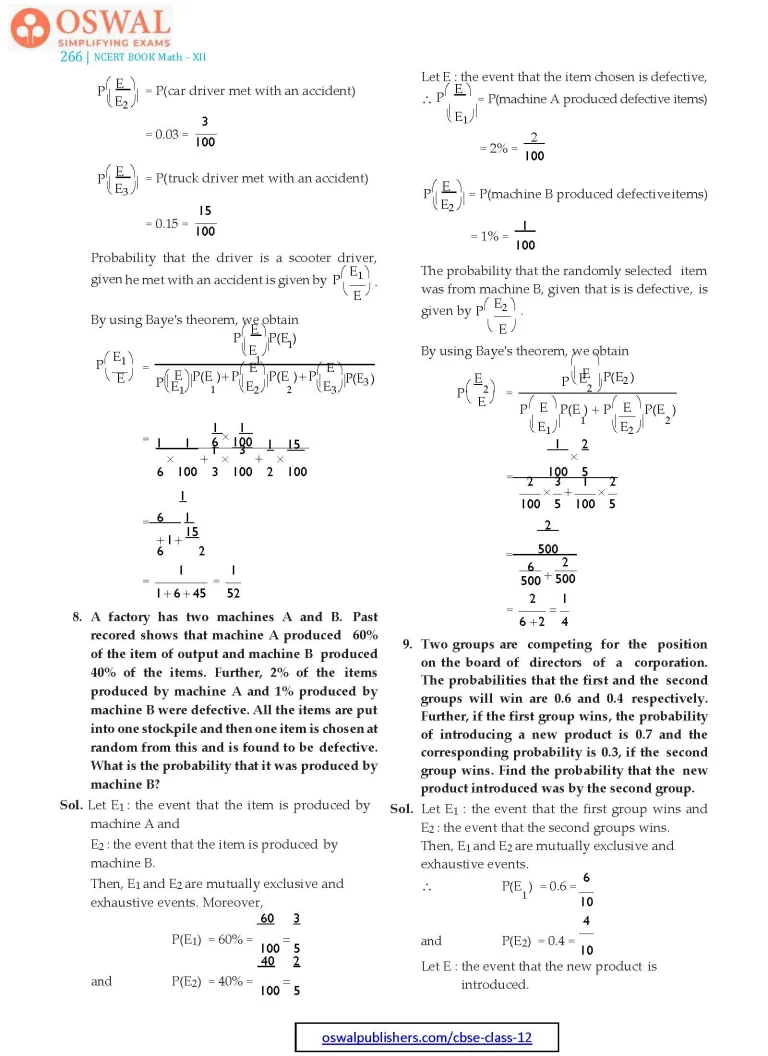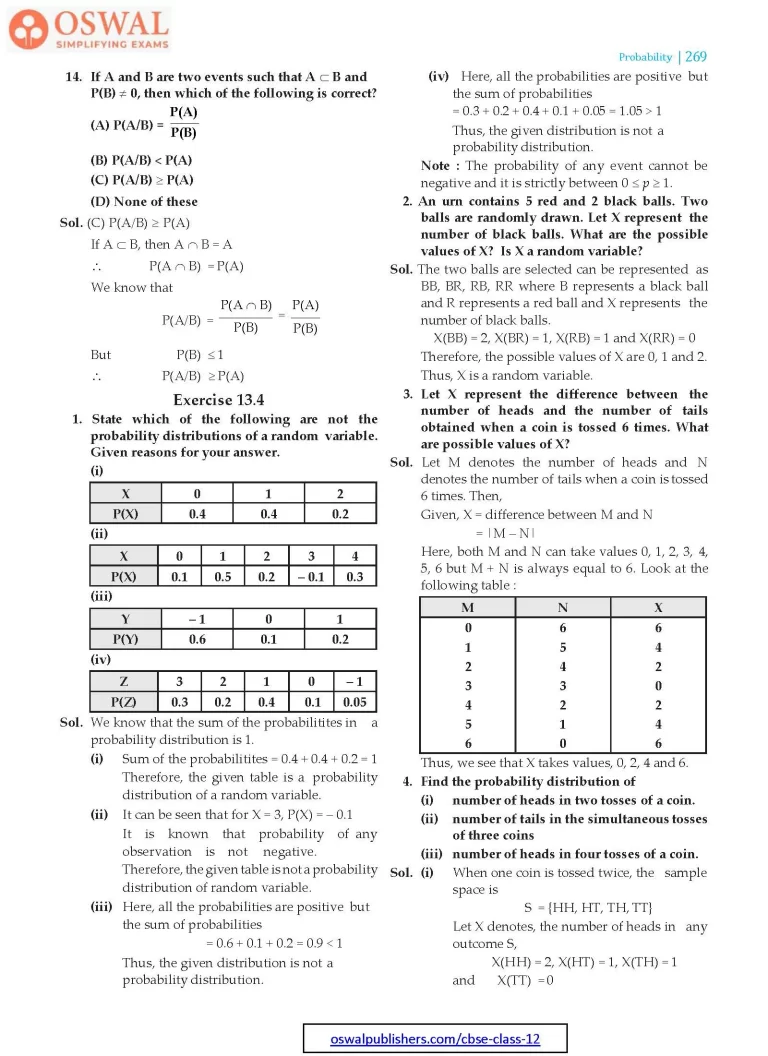NCERT Solutions for Class 12 Maths Chapter 13 - Probability - Exercise 13.3







Access Exercises of Class 12 Maths Chapter 13 – Probability
Exercise 13.1 Solutions 17 Questions
Exercise 13.2 Solutions 18 Questions
Exercise 13.3 Solutions 14 Questions
Exercise 13.4 Solutions 17 Questions
Exercise 13.5 Solutions 15 Questions
Miscellaneous Exercise on Chapter 13 Solutions 10 Questions
Exercise 13.3
1. An urn contains 5 red and 5 black balls. A ball is drawn at random, its colour is noted and is returned to the urn. Moreoever, 2 additional balls of the colour drawn are put in the urn and then a ball is drawn at random. What is the probability that the second ball is red?
Sol. The urn contains 5 red and 5 black balls.
i.e., n(R) = 5, n(B) = 5 and n(S) = 10
Let a ball be drawn in the first attempt.
$$\therefore\space\text{P(drawing a red ball)}\\=\frac{\text{n(R)}}{\text{n(S)}} = \frac{5}{10} =\frac{1}{2}$$
If two red balls are added to urn, then the urn contains 7 red and 5 black balls i.e.,
n(R) = 7, n(B) = 5 and n(S) = 12
$$\text{P(drawing a red ball)}\\=\frac{\text{n(R)}}{\text{n(S)}}= \frac{7}{12}$$
Let a black ball be drawn in the first attempt
Then, n(R) = 5, n(B) = 5 and n(S) = 10
∴ P(drawing a black ball in the first attempt)
$$= \frac{\text{n(B)}}{\text{n(S)}} = \frac{5}{10} =\frac{1}{2}$$
If two black balls are added to the urn, then the urn contains 5 red and 7 black balls.
i.e., n(R) = 5, n(B) = 7 and n(S) = 12
$$\therefore\space\text{P(drawing a red ball) =}\\\frac{\text{n(R)}}{\text{n(S)}} =\frac{5}{12}$$
Therefore, probability of drawing second ball as red is
$$=\frac{1}{2}×\frac{7}{12} + \frac{1}{2}×\frac{5}{12}\\=\frac{1}{2}\bigg(\frac{7}{12} + \frac{5}{12}\bigg)\\=\frac{1}{2}×1 =\frac{1}{2}$$
2. A bag contains 4 red and 4 black balls, another bag contains 2 red and 6 black balls. One of the two bags is selected at random and a ball is drawn from the bag which is found to be red. Find the probability that the ball is drawn from the first bag.
Sol. Let E1 : first bag is selected, E2 : second bag is selected.
Then, E1 and E2 are mutually exclusive and exhaustive events. Moreover,
$$\text{P(E}_1) = \text{P(E}_2) = \frac{1}{2}$$
Let E : ball drawn is red.
$$\therefore\space \text{P}\bigg(\frac{\text{E}}{\text{E}_2}\bigg) = \text{P}\\\text{(drawing a red ball} \\\text{from second bag)}\\=\frac{2}{8} =\frac{1}{4}$$
By Baye's theorem,
$$\text{Required probability =}\\\text{P}\bigg(\frac{\text{E}_1}{\text{E}}\bigg)\\=\frac{\text{P}\bigg(\frac{\text{E}}{\text{E}_1}\bigg)\text{P}(\text{E}_1)}{\text{P}\bigg(\frac{\text{E}}{\text{E}_1}\bigg)\text{P(E}_1) + \text{P}\bigg(\frac{\text{E}}{\text{E}_2}\bigg)\text{P}(\text{E}_2)}\\=\frac{\frac{1}{2}×\frac{1}{2}}{\frac{1}{2}×\frac{1}{2} + \frac{1}{2}×\frac{1}{4}}\\=\frac{\frac{1}{4}}{\frac{1}{4} + \frac{1}{8}}\\=\frac{\frac{1}{4}}{\frac{2+1}{8}} = \frac{\frac{1}{4}}{\frac{3}{8}}$$
$$= \frac{1}{4}×\frac{8}{3} =\frac{2}{3}$$
3. Of the students in a college, it is known that 60% reside in hostel and 40% are day scholars (not residing in hostel). Previous year results report that 30% of all students who reside in hostel attain A grade and 20% of day scholars attain A grade in their annual examination. At the end of the year, one student is chosen at random from the college and he has an A grade, what is the probability that the student is a hostlier?
Sol. Let E1 : the event that the students is residing in hostel
and E2 : the event that the students in not residing in the hostel.
Let E : a student attains A grade,
Then, E1 and E2 are mutually exclusive and exhaustive events. Moreover,
$$\text{P}(E_1) = 60\% =\\\frac{60}{100} = \frac{3}{5}\\\text{and}\space\text{P}(\text{E}_2) = 40\% = \\\frac{40}{100} =\frac{2}{5}\\\text{Then,}\space\text{P}\bigg(\frac{\text{E}}{\text{E}_1}\bigg) = 30\%\\=\frac{30}{100}=\frac{3}{10} $$
$$\text{and}\space \text{P}\bigg(\frac{\text{E}}{\text{E}_2}\bigg) = 20\%\\=\frac{20}{100} =\frac{2}{10}$$
By using Baye's theorme, we obtain
$$\text{P}\bigg(\frac{\text{E}}{\text{E}_1}\bigg) \\=\frac{\text{P}\bigg(\frac{\text{E}}{\text{E}_1}\bigg)\text{P}(\text{E}_1)}{\text{P}\bigg(\frac{\text{E}}{\text{E}_1}\bigg)\text{P}(\text{E}_1) + \text{P}\bigg(\frac{\text{E}}{\text{E}_2}\bigg)\text{P}(\text{E}_2)}\\=\frac{\frac{3}{10}×\frac{3}{5}}{\frac{3}{10}×\frac{3}{5} + \frac{2}{10}×\frac{2}{5}}\\=\frac{9}{9 + 4}= \frac{9}{13}$$
4. In answering a question on a mutliple choice test, a student either knows the answer or guesses.
$$\textbf{Let\space}\frac{\textbf{3}}{\textbf{4}}\space\textbf{be the probability that he}\\\textbf{knows the answer and}\space\frac{\textbf{1}}{\textbf{4}}\textbf{be the}$$ probability that he guesses. Assuming that a student who guesses at the answer will be correct with probability $$\frac{\textbf{1}}{\textbf{4}}\textbf{.}\space\textbf{What is the probability} $$
that the student knows the answer given that he answered it correctly?
Sol. Let E1 : the event that the students knows the answer and E2 : the event that the student guesses the answer.
Therefore, E1 and E2 are mutually exclusive and exhaustive events.
$$\therefore\space \text{P(E}_1) = \frac{3}{4}\space\text{and P}(\text{E}_2) = \frac{1}{4} $$
Let E : the answer is correct.
The probability that the student answered correctly given that he knows the answer, is 1 i.e.
$$\text{P}\bigg(\frac{\text{E}}{\text{E}_1}\bigg) = 1$$
Probability that the students answered correctly, given that the he guessed, is
$$\frac{1}{4}\space\text{i.e.,}$$
$$\text{P}\bigg(\frac{\text{E}}{\text{E}_2}\bigg)=\frac{1}{4}.$$
By using Baye's theorem, we obtain
$$\text{P}\bigg(\frac{\text{E}_1}{\text{E}}\bigg) =\\\frac{\text{P}\bigg(\frac{\text{E}}{\text{E}_1}\bigg)\text{P}(\text{E}_1)}{\text{P}\bigg(\frac{\text{E}}{\text{E}_1}\bigg)\text{P}(\text{E}_1) + \text{P}\bigg(\frac{\text{E}}{\text{E}_1}\bigg)\text{P}(\text{E}_2)}\\=\frac{1×\frac{3}{4}}{1×\frac{3}{4} + \frac{1}{4}×\frac{1}{4}}\\=\frac{\frac{3}{4}}{\frac{3}{4} +\frac{1}{16}} =\frac{\frac{3}{4}}{\frac{12+1}{6}}\\=\frac{3}{4}×\frac{16}{13} = \frac{12}{13}$$
Note : If two events are not mutually exclusive/exhaustive, then you do not use Baye's theorem.
5. A laboratory blood test is 99% effective in detecting a certain disease when it is in fact, present. However, the test also yields a false positive result for 0.5% of the healthy person tested (i.e., if a healthy person is tested, then, with probability 0.005, the test will imply he has the disease). If 0.1% of the population actually has the disease, what is the probability that a person has the disease given that his test result is positive?
Sol. Let E1 : the event that the person has disease and E2 : the event that the person is healthy.
Then, E1 and E2 are mutually exclusive and exhaustive events.
$$\text{Moreever,}\space\text{P(E}_1) =0.1\% \\= \frac{0.1}{100} = 0.001$$
and P(E2) = 1 – 0.001 = 0.999
Let E : the event that test is positive.
$$\text{P}\bigg(\frac{\text{E}}{\text{E}_1}\bigg) = \text{(P(result is positive}\\\text{given the person has disease})\\ = 99\% = \frac{99}{100} = 0.99$$
Probability that a person does not have disease and test result is positive.
$$\therefore\space \text{P}\bigg(\frac{\text{E}}{\text{E}_2}\bigg) = 0.5\% \\= \frac{0.5}{100} = 0.005$$
By using Baye's theorem, we obtain
$$\text{P}\bigg(\frac{\text{E}_1}{\text{E}}\bigg)= \\\frac{\text{P}\bigg(\frac{\text{E}}{\text{E}_1}\bigg)\text{P}(\text{E}_1)}{\text{P}\bigg(\frac{\text{E}}{\text{E}_1}\bigg)\text{P}(\text{E}_1) + \text{P}\bigg(\frac{\text{E}}{\text{E}_2}\bigg)\text{P}(\text{E}_2)}$$
$$=\frac{0.001×0.99}{0.001×0.99×0.999×0.005}\\=\frac{0.00099}{0.00099 + 0.004995}\\ = \frac{0.00099}{0.005985} =\frac{990}{5985}\\=\frac{110}{665} = \frac{22}{133}$$
6. There are three coins. One is a two headed coin (having head on both faces), another is a biased coin that comes up heads 75% of the time and third is an unbiased coin. One of the three coins is chosen at random and tossed, it shows heads, what is the probability that it was the two headed coin?
Sol. Let E1 : the event that the coin chosen is two headed,
E2 : the event that the coin chosen is biased and E3 : the event that the coin chosen is unbiased.
⇒ E1, E2, E3 are mutually exclusive and exhausitive events. Morever,
$$\text{P(E}_1) =\text{P(E}_2) =\text{P(E}_3) = \frac{1}{3}$$
Let E : tossed coin shows up a head,
$$\therefore\space\text{P}\bigg(\frac{\text{E}}{\text{E}_1}\bigg) = \text{P (coin showing}\\\text{heads, given that it is a two}\\\text{headed coin)}=1\\\text{P}\bigg(\frac{\text{E}}{\text{E}_2}\bigg) =\text{P}(\text{coin showing heads,}\\\text{given that it is a biased coin})\\=75\% =\frac{75}{100} =\frac{3}{4}$$
$$\text{P}\bigg(\frac{\text{E}}{\text{E}_2}\bigg) =\text{P}(\text{coin showing head,}\\\text{given that it is an unbiased coin})\\=\frac{1}{2}$$
The probability that the coin is two headed, given that is shows head, is given by
$$\text{P}\bigg(\frac{\text{E}_1}{\text{E}}\bigg)$$
By using Baye's theorem, we obtain
$$\text{P}\bigg(\frac{\text{E}_1}{\text{E}}\bigg) =\\\frac{\text{P}\bigg(\frac{E}{E_1}\bigg)\text{P(\text{E}}_1)}{\text{P}\bigg(\frac{E}{\text{E}_1}\bigg)\text{P}(\text{E}_1) + \text{P}\bigg(\frac{\text{E}}{\text{E}_2}\bigg)\text{P}\text{(E}_2) + \text{p}\bigg(\frac{\text{E}}{\text{E}_3}\bigg)\text{P}(\text{E}_3)}\\=\frac{1×\frac{1}{3}}{1×\frac{1}{3} + \frac{3}{4}×\frac{1}{3} + \frac{1}{2}×\frac{1}{3}}\\=\frac{1}{1 + \frac{3}{4} + \frac{1}{2}}\\=\frac{1}{\frac{4+3+2}{4}} =\frac{4}{9}$$
7. An insurance company insured 2000 scooter drivers, 4000 car drivers and 6000 truck drivers. The probability of an accidents are 0.01, 0.03 and 0.15 respectively. One of the insured persons meets with an accident. What is the probability that he is a scooter driver?
Sol. There are 2000 scooter drivers, 4000 car drivers and 6000 truck drivers.
Total number of drivers
= 2000 + 4000 + 6000
= 12000
Let E1 : the event that insured person is a scooter driver,
E2 : the event that insured person is a car driver and E3 : the event that insured person is a truck driver.
Then, E1, E2, E3 are mutually exclusive and exhaustive events. Moreover,
$$\text{P(E}_1) =\\\frac{\text{Number of scooter drivers}}{\text{Total number of drivers}}\\=\frac{2000}{12000} = \frac{1}{6}\\\text{P(E}_2) =\\ \frac{\text{Number of car drivers}}{\text{Total number of drivers}}\\=\frac{4000}{12000} =\frac{1}{3}\\\text{and}\space\text{P}(\text{E}_3) =\\\frac{\text{Number of truck drivers}}{\text{Total number of drivers}}\\=\frac{6000}{12000}= \frac{1}{2}$$
Let E : the events that insured person meets with an accident.
$$\text{P}\bigg(\frac{\text{E}}{\text{E}_1}\bigg) = \text{P(scooter driver met}\\\text{with an accident)}\\= 0.01 = \frac{1}{100}\\\text{P}\bigg(\frac{\text{E}}{\text{E}_2}\bigg) =\text{P}(\text{car driver met}\\\text{ with an accident})\\=0.03 = \frac{3}{100}\\\text{P}\bigg(\frac{\text{E}}{\text{E}_3}\bigg)= \text{P}\text{(truck driver met}\\\text{ with an accident)}\\=0.15 = \frac{15}{100}$$
Probability that the driver is a scooter driver, given he met with an accident is given by
$$\text{P}\bigg(\frac{\text{E}_1}{\text{E}}\bigg).$$
By using Baye's theorem, we obtain
$$\text{P}\bigg(\frac{\text{E}_1}{\text{E}}\bigg) =\\\frac{\text{P}\bigg(\frac{\text{E}}{\text{E}_1}\bigg)\text{P}(\text{E}_1)}{\text{P}\bigg(\frac{\text{E}}{\text{E}_1}\bigg)\text{P}(\text{E}_1) + \text{P}\bigg(\frac{\text{E}}{\text{E}_2}\bigg)\text{P}(\text{E}_2) +\text{P}\bigg(\frac{E}{\text{E}_3}\bigg)\text{P}(\text{E}_3)}$$
$$= \frac{\frac{1}{6}×\frac{1}{100}}{\frac{1}{6}×\frac{1}{100} + \frac{1}{3}×\frac{3}{100} + \frac{1}{2}×\frac{15}{100}}\\=\frac{\frac{1}{6}×\frac{1}{100}}{\frac{1}{6}×\frac{1}{100} + \frac{1}{3}×\frac{3}{100} + \frac{1}{2}×\frac{15}{100}}\\=\frac{\frac{1}{6}}{\frac{1}{6} + 1+\frac{15}{2}}\\=\frac{1}{1 + 6 + 45} =\frac{1}{52}$$
8. A factory has two machines A and B. Past recored shows that machine A produced 60% of the item of output and machine B produced 40% of the items. Further, 2% of the items produced by machine A and 1% produced by machine B were defective. All the items are put into one stockpile and then one item is chosen at random from this and is found to be defective. What is the probability that it was produced by machine B?
Sol. Let E1 : the event that the item is produced by machine A and
E2 : the event that the item is produced by machine B.
Then, E1 and E2 are mutually exclusive and exhaustive events. Moreover,
$$\text{P}(\text{E}_1) = 60\% = \frac{60}{100} =\frac{3}{5}\\\text{and}\space\text{P(E}_2) = 40\%\\=\frac{40}{100} = \frac{2}{5}$$
Let E : the event that the item chosen is defective,
$$\therefore\space\text{P}\bigg(\frac{\text{E}}{\text{E}_1}\bigg) =\text{P}(\text{machine A produced}\\\text{ defective items})$$
$$ = 2\% = \frac{2}{100}\\\text{P}\bigg(\frac{\text{E}}{\text{E}_2}\bigg) =\text{P(machine B produced}\\\text{defective items)}\\ = 1\% = \frac{1}{100}$$
The probability that the randomly selected item was from machine B, given that is is defective, is given by
$$\text{P}\bigg(\frac{\text{E}_2}{\text{E}}\bigg).$$
By using Baye's theorem, we obtain
$$\text{P}\bigg(\frac{\text{E}_2}{\text{E}}\bigg) = \\\frac{\text{P}\bigg(\frac{\text{E}}{\text{E}_2}\bigg)\text{P}(\text{E}_2)}{\text{P}\bigg(\frac{E}{E_1}\bigg)\text{P}(\text{E}_1) + \text{P}\bigg(\frac{E}{E_2}\bigg)\text{P}(\text{E}_2)}\\=\frac{\frac{1}{100}×\frac{2}{5}}{\frac{2}{100}×\frac{3}{5} + \frac{1}{100}×\frac{2}{5}}\\=\frac{\frac{2}{500}}{\frac{6}{500} + \frac{2}{500}}\\=\frac{2}{6 +2} = \frac{1}{4}$$
9. Two groups are competing for the position on the board of directors of a corporation. The probabilities that the first and the second groups will win are 0.6 and 0.4 respectively. Further, if the first group wins, the probability of introducing a new product is 0.7 and the corresponding probability is 0.3, if the second group wins. Find the probability that the new product introduced was by the second group.
Sol. Let E1 : the event that the first group wins and E2 : the event that the second groups wins.
Then, E1 and E2 are mutually exclusive and exhaustive events.
$$\therefore\space\text{P(E}_1) = 0.6 = \frac{6}{10}\\\text{and}\space \text{P}(\text{E}_2) = 0.4 = \frac{4}{10}$$
Let E : the event that the new product is introduced.
$$\text{P}\bigg(\frac{\text{E}}{\text{E}_1}\bigg) = \text{P}(\text{introducing a new ,}\\\text{product if the first group wins})\\ =0.7 = \frac{7}{10}\\\therefore\space\text{P}\bigg(\frac{\text{E}}{\text{E}_2}\bigg) = \text{P(introducing a new},\\\text{product, if the second group wins)}\\=0.3 =\frac{3}{10}$$
Probability that the new product is introduced by the second group is given by
$$\text{P}\bigg(\frac{\text{E}_2}{\text{E}}\bigg).$$
By using Baye's theorem, we obtain
$$\text{P}\bigg(\frac{\text{E}_2}{\text{E}}\bigg) =\\\frac{\text{P}\bigg(\frac{\text{E}}{\text{E}_2}\bigg)\text{P}\text{(E}_2)}{\text{P}\bigg(\frac{\text{E}}{\text{E}_1}\bigg)\text{P}(\text{E}_1) + \text{P}\bigg(\frac{\text{E}}{\text{E}_2}\bigg)\text{P}(\text{E}_2)}\\=\frac{\frac{3}{10}×\frac{4}{10}}{\frac{7}{10}×\frac{6}{10} + \frac{3}{10}×\frac{4}{10}}\\=\frac{12}{42 + 12} = \frac{12}{54} = \frac{2}{9}.$$
10. Suppose, a girl throws a dice. If she gets a 5 or 6, she tosses a coin three times and notes the number of heads. If she gets 1, 2, 3 or 4, she tosses a coin once and notes whether a head or tail is obtained. If she obtained exactly one head, what is the probability that she threw 1, 2, 3 or 4 with the die?
Sol. Let E1 : the event that 5 or 6 is shown on die and E2 : the event that 1, 2, 3 or 4 is shown on die.
Then, E1 and E2 are mutually exclusive and exhaustive events.
and n(E1) = 2, n(E2) = 4
Also, n(S) = 6
$$\therefore\space\text{P}(\text{E}_1) = \frac{2}{6} =\frac{1}{3}\\\text{and}\space \text{P}(\text{E}_2) = \frac{4}{6} =\frac{2}{3}$$
Let E : Event that exactly one head shows up,
$$\therefore\text{P}\bigg(\frac{\text{E}}{\text{E}_1}\bigg) = \text{P(exactly one head}\\\text{shows up when coin is tossed thrice)}\\ =\text{P}\lbrace\text{HTT, THT, TTH}\rbrace= \frac{3}{8}\\(\because\space \text{Total number of events} = 2^{3} = 8)\\\text{P}\bigg(\frac{\text{E}}{\text{E}_2}\bigg) =\text{P}\text{(head shows up when)}\\\text{coin is tossed once)}\\=\frac{1}{2}$$
Probability that the girls threw 1, 2, 3 or 4 with the die, if she obtained exactly one head, is given by
$$\text{P}\bigg(\frac{\text{E}_2}{\text{E}}\bigg).$$
By using Baye's theorem, we obtain
$$\text{P}\bigg(\frac{\text{E}_2}{\text{E}}\bigg) = \\\frac{\text{P}\bigg(\frac{\text{E}}{\text{E}_2}\bigg)\text{P}(\text{E}_2)}{\text{P}\bigg(\frac{\text{E}}{\text{E}_1}\bigg)\text{P}(\text{E}_1) + \text{P}\bigg(\frac{\text{E}}{\text{E}_2}\bigg)\text{P}\text{(E}_2)}\\=\frac{\frac{1}{2}×\frac{2}{3}}{\frac{3}{8}×\frac{1}{3} + \frac{1}{2} × \frac{2}{3}}\\=\frac{\frac{1}{3}}{\frac{1}{3} + \frac{1}{8}}\\=\frac{8}{8+3} =\frac{8}{11}$$
11. A manufacturer has three machine operators A, B and C. The first operator A produces 1% defective items, where as the other two operators B and C produce 5% and 7% defective items, respectively. A is on the job for 50% of the time, B on the job for 30% of the time and C is on the job for 20% of the time. A defective item is produced, what is the probability that it was produced by A?
Sol. Let E1 : the event that item is produced by machine A,
E2 : the event that item is produced by machine B and E3 : the event that item is produced by machine C.
Here, E1, E2 and E3 are mutually exclusive and exhaustive events.
Moreover,
$$\text{P}\text{(E}_1) = 50\% = \frac{50}{100}\\\text{P}(\text{E}_2) = 30\% =\frac{30}{100}\\\text{and}\space\text{P}(\text{E}_3) = 20\% =\frac{20}{100}$$
Let E : Event that item chosen is found to be defective,
$$\therefore\space\text{P}\bigg(\frac{\text{E}}{\text{E}_1}\bigg)= \frac{1}{100}\\\text{P}\bigg(\frac{\text{E}}{\text{E}_2}\bigg) =\frac{5}{100}\\\text{and\space}\text{P}\bigg(\frac{\text{E}}{\text{E}_3}\bigg) = \frac{7}{100}$$
By using Baye's theorem, we obtain
$$\text{P}\bigg(\frac{\text{E}_1}{\text{E}}\bigg) = \\\frac{\text{P}\bigg(\frac{\text{E}}{\text{E}_1}\bigg)\text{P}(\text{E}_1)}{\text{P}\bigg(\frac{\text{E}}{\text{E}_1}\bigg)\text{P(E}_1) + \text{P}\bigg(\frac{\text{E}}{\text{E}_2}\bigg)\text{P}(\text{E}_2) + \text{P}\bigg(\frac{\text{E}}{\text{E}_3}\bigg)\text{P}(\text{E}_3)}\\=\\\frac{\frac{1}{100}×\frac{50}{100}}{\frac{1}{100}×\frac{50}{100} + \frac{5}{100}×\frac{30}{100} + \frac{7}{100}×\frac{20}{100}}\\= \frac{50}{50 + 150 +140} = \frac{50}{340}\\=\frac{5}{34}$$
12. A card from a pack of 52 cards is lost. From the remaining cards of the pack, two cards are drawn and are found to be both diamonds. Find the probability of the lost card being a diamond.
Sol. Let E1 : the event that the lost cards is a diamond
⇒ n(E1) = 13
E2 : lost cards is not a diamond
⇒ n(E2) = 52 – 13 = 39
and n(S) = 52
Then, E1 and E2 are mutually exclusive and exhaustive events.
$$\therefore\space\text{P(E}_1) = \frac{13}{52}= \frac{1}{4}\\\text{and}\space\text{P(E}_2) =\frac{39}{52} = \frac{3}{4}$$
Let E : the event that two cards drawn from the remaining pack are diamonds,
When one diamond card is lost, there are 12 diamond cards out of 51 cards.
The cards can be drawn out of 12 diamond cards is 12C2 ways.
Similarly, 2 diamond cards can be drawn out of 51 cards in 51C2 ways. The probability of getting two cards, when one diamond card is lost, is given by
$$\text{P}\bigg(\frac{\text{E}}{\text{E}_1}\bigg).\\\therefore\space\text{P}\bigg(\frac{\text{E}}{\text{E}_1}\bigg)= \frac{^{12}\text{C}_2}{^{51}\text{C}_2}\\=\frac{\frac{12×11}{1×2}}{\frac{51×50}{1×2}}= \frac{12×11}{51×50}\\\text{and}\space\text{P}\bigg(\frac{\text{E}}{\text{E}_2}\bigg) = \frac{^{13}\text{C}_{2}}{^{51}\text{C}_{2}}\\ =\frac{\frac{13×12}{1×2}}{\frac{51×50}{1×2}} = \frac{13×12}{51×50}$$
By using Baye's theorem, we obtain
$$\text{P}\bigg(\frac{\text{E}_1}{\text{E}}\bigg) = \\\frac{\text{P}\bigg(\frac{\text{E}}{\text{E}_1}\bigg)\text{P}(\text{E}_1)}{\text{P}\bigg(\frac{\text{E}}{\text{E}_1}\bigg)\text{P}(\text{E}_1) + \text{P}\bigg(\frac{\text{E}}{\text{E}_2}\bigg)\text{P(\text{E}}_2)}\\=\frac{\frac{12×11}{51×50}×\frac{1}{4}}{\frac{12×11}{51×50}×\frac{1}{4} + \frac{13×12}{51×50}×\frac{3}{4}}\\=\frac{12×11}{12×11 + 13×12×3}\\=\frac{132}{132 + 468} = \frac{132}{600}\\=\frac{11}{50}$$
13. Probability that A speaks truth is
$$\frac{\textbf{4}}{\textbf{5}}\textbf{.}\space\textbf{A coin is tossed.}$$
A reports that a head appears. The probability that actually there was head is :
$$\textbf{(A)\space}\frac{\textbf{4}}{\textbf{5}}\\\textbf{(B)\space}\frac{\textbf{1}}{\textbf{2}}\\\textbf{(C)\space}\frac{\textbf{1}}{\textbf{5}}\\\textbf{(D)\space}\frac{\textbf{2}}{\textbf{5}}\\\textbf{Sol.}\space\text{(A)\space}\frac{4}{5}$$
Let E1 : the event that coins comes up with a head,
E2 : the event that coin comes up with a tail.
Then, E1 and E2 are mutually exclusive and exhaustive events. Moreover,
$$\text{P}(\text{E}_1) = \text{P}(\text{E}_2)= \frac{1}{2}$$
E : the events that A reports that a head appears,
$$\therefore\space\text{P}\bigg(\frac{\text{E}}{\text{E}_1}\bigg) = \text{P}(\text{head comes up and}\\\text{A speaks truth})\\=\frac{4}{5}\\\text{P}\bigg(\frac{\text{E}}{\text{E}_2}\bigg) = \text{P}(\text{tails comes up and}\\\text{speaks lie})\\=\frac{1}{5}$$
Probability that there is actually a head is given by
$$\text{P}\bigg(\frac{\text{E}_1}{\text{E}}\bigg).$$
By using Baye's theorem, we obtain
$$\text{P}\bigg(\frac{\text{E}_1}{\text{E}}\bigg) =\\\frac{\text{P}\bigg(\frac{\text{E}}{\text{E}_1}\bigg)\text{P}(\text{E}_1)}{\text{P}\bigg(\frac{\text{E}}{\text{E}_1}\bigg)\text{P}(\text{E}_1) + \text{P}\bigg(\frac{\text{E}}{\text{E}_2}\bigg)\text{P}\text{(E}_2)}\\=\frac{\frac{4}{5}×\frac{1}{2}}{\frac{4}{5}×\frac{1}{2} + \frac{1}{5}×\frac{1}{2}}\\=\frac{4}{4+1} = \frac{4}{5}$$
14. If A and B are two events such that A ⊂ B and P(B) ≠ 0, then which of the following is correct?
$$\textbf{(A)\space P(A/B)} = \frac{\textbf{P(A)}}{\textbf{P(B)}}\\\textbf{(B)\space}\textbf{P(A/B)}\lt \textbf{P}\textbf{(A)}\\\textbf{(C) P(A/B)}\geq\textbf{P(A)}$$
(D) None of these
Sol. (C) P(A/B) ≥ P(A)
If A ⊂ B, then A ∩ B = A
∴ P(A ∩ B) = P(A)
We know that
$$\text{P}(A/B) =\frac{\text{P}(A\cap B)}{\text{P(B)}}\\=\frac{\text{P(A)}}{\text{P(B)}}$$
But P(B) ≤ 1
∴ P(A/B) ≥ P(A)
Share page on
NCERT Solutions Class 12 Mathematics
- Chapter 1 Relations and Functions
- Chapter 2 Inverse Trigonometric Functions
- Chapter 3 Matrices
- Chapter 4 Determinants
- Chapter 5 Continuity and Differentiability
- Chapter 6 Application of Derivatives
- Chapter 7 Integrals
- Chapter 8 Applications of the Integrals
- Chapter 9 Differential Equations
- Chapter 10 Vectors
- Chapter 11 Three-Dimensional Geometry
- Chapter 12 Linear Programming
- Chapter 13 Probability
CBSE CLASS 12 NCERT SOLUTIONS
- NCERT Solutions Class 12 English Core
- NCERT Solutions Class 12 Physics
- NCERT Solutions Class 12 Chemistry
- NCERT Solutions Class 12 Biology
- NCERT Solutions Class 12 Business Studies
- NCERT Solutions Class 12 Mathematics
- NCERT Solutions Class 12 Accountancy
- NCERT Solutions Class 12 Economics
- NCERT Solutions Class 12 Geography
- NCERT Solutions Class 12 History
- NCERT Solutions Class 12 Political Science
CBSE CLASS 12 SYLLABUS
- CBSE Class 12 English core Syllabus
- CBSE Class 12 Mathematics Syllabus
- CBSE Class 12 Physics Syllabus
- CBSE Class 12 Chemistry Syllabus
- CBSE Class 12 Biology Syllabus
- CBSE Class 12 Accountancy Syllabus
- CBSE Class 12 Business Studies Syllabus
- CBSE Class 12 Economics Syllabus
- CBSE Class 12 History Syllabus
- CBSE Class 12 Geography Syllabus
- CBSE Class 12 Political science Syllabus
- CBSE Class 12 Sociology Syllabus
- CBSE Class 12 Psychology Syllabus
- CBSE Class 12 Physical education Syllabus
- CBSE Class 12 Applied mathematics Syllabus
- CBSE Class 12 History of Indian Arts Syllabus
CBSE CLASS 12 Notes
- CBSE Class 12 Physics Notes
- CBSE Class 12 Chemistry Notes
- CBSE Class 12 Biology Notes
- CBSE Class 12 Maths Notes
- CBSE Class 12 Accountancy Notes
- CBSE Class 12 Business Studies Notes
- CBSE Class 12 Economics Notes
- CBSE Class 12 History Notes
- CBSE Class 12 Geography Notes
- CBSE Class 12 Political Science Notes

